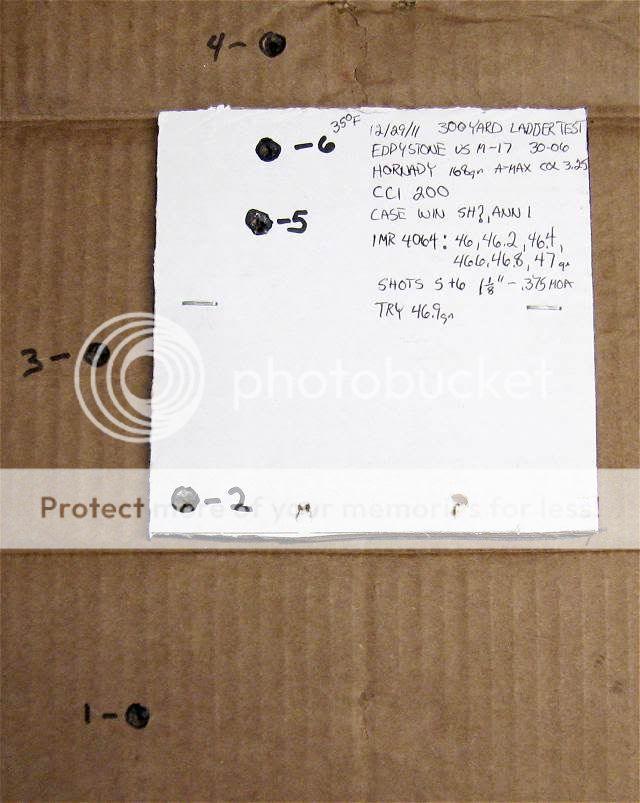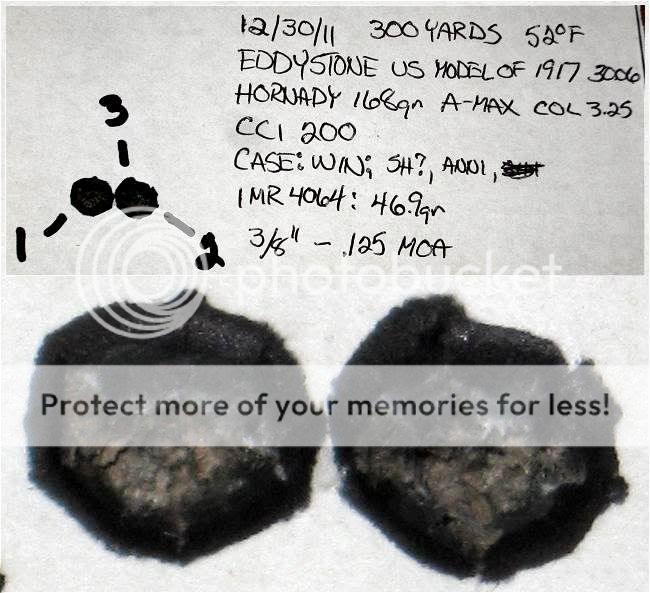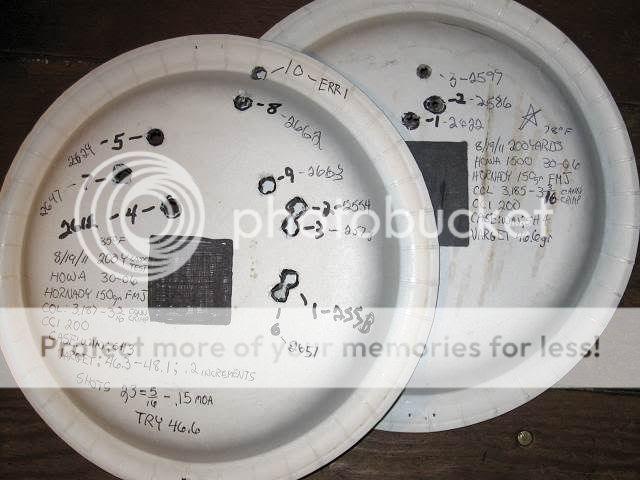What do you guys think the barrel weight contributes to cold shot performance? Since the scenario in mid to big game would be we are always shooting at an animal with a "cold shot", does the advantage (if any) of a heavier profile or contour justify the extra weight to lug around? For example, a 26"light or medium sporter contour barrel against the heavy contours I see on many of the rifles posted here. Is the heavier barrel worth .25", .45" over its lighter counterpart? I am of course talking about equal quality barrels.
You are using an out of date browser. It may not display this or other websites correctly.
You should upgrade or use an alternative browser.
You should upgrade or use an alternative browser.
Weight vs cold shot
- Thread starter kennygss
- Start date
 Help Support Long Range Hunting Forum
Help Support Long Range Hunting Forum
justgoto
Well-Known Member
I used to think the 'cold-bore' deviation was rifle specific.
Now I know it to be load specific; so I load develop with the notion of eliminating it. Now none of my rifles have a 'cold-bore' deviation.
Now I know it to be load specific; so I load develop with the notion of eliminating it. Now none of my rifles have a 'cold-bore' deviation.
I'm not so sure of whether it's conclusive or not but my heavier barrel rifles are generally more accurate with cold bore shots then my lighter weight barrels. I say it's not conclusive because I do have a couple of sporter weight barreled rifles that will send a cold bore shot to the same spot with excellent accuracy equal to my heavy barreled rifles. I don't think I would add the weight for that reason only, especially if the added weight was a hindrance to the rifle's specific purpose. My primary hunting rifles fall in the middle of the barrel weight range, #6 size barrel approx, with end diameters of .73-.75. The total weight runs about 10-10.5#. It's a compromise that serves both my carry and precision long range shooting needs. I like this weight primarily because it provides a stable shooting platform for the long shots, and at the same time doesn't make me feel like I'm carrying a crowbar around with me. These barrels will deliver cold bore performance that is consistent with my best groups shot consecutively with a warm bore.
kcebcj
Well-Known Member
My hunting rifle for a long time weighed 8.5 lbs loaded with the strap on....22 inch thin barrel. My rifle today is 10.5 fully loaded with the strap on....26 inch #5 barrel. Cold bore they both are very accurate but what I learned is the heavier rifle is more accurate to shoot under field conditions. What I mean is if I shoot 5 shots off my knees at a 200 yard target with each and each shot is a cold bore the heavier rifles group will be better even though they both are equally accurate. It seems that I can hold the heavier rifle more still and because of the weight it just doesn't move around as much. Does that make sense to you?
So is the barrel weight worth the tradeoff...depends. If I backpacked today like I used to it would be the lighter rifle without question but today I will take the 10.5 lbs rifle and sleep on a cot every night.
So is the barrel weight worth the tradeoff...depends. If I backpacked today like I used to it would be the lighter rifle without question but today I will take the 10.5 lbs rifle and sleep on a cot every night.
NW Hunter
Well-Known Member
kcebcj, I like your style
Hmmm. Here's my experience. While the heavy barrels may dampen harmonics, and heat slower. 95% of the advantage is greater stability.
I always fire a couple foulers. I might hunt two months with the rifle before I clean again. I don't see a shift in point of impact between cold bore and a couple rounds on my precision rigs.
In the weight vs packability and handling I prefer a midweight rig most of the time. Say a 27" #6 in a Manners GAT. I hunt high, hard, and steeeeep.
I always fire a couple foulers. I might hunt two months with the rifle before I clean again. I don't see a shift in point of impact between cold bore and a couple rounds on my precision rigs.
In the weight vs packability and handling I prefer a midweight rig most of the time. Say a 27" #6 in a Manners GAT. I hunt high, hard, and steeeeep.
What set me thinking on this is the basic ritual of hunting. Pre-hunt sight in, travel, fire and foul to verify zero, then go hunt. Ultimately, if the Great Spirit sees fit, you shoot at an animal. IF one can deliver the "magic bullet" from a whispy barrel, why carry that 12 lb rifle all over creation? For example, I have a 1939 M70 winny in 06' that will deliver its favorite load to the "x" first shot everytime, After that, not much deviaton, but deviation nontheless. I have a steyr SSG that will do it , I dunno, like 200 times. LoL. Perhaps age is catching up with me and the answer is a "heavy style" rifle including stock design etc, but built light. Rairly have I shot more that once at an animal. ( can you fella see I am talking myself into a reason to get a new rifle. . . .LoL)
heavy short barrels are the best for all around consistency. this is why the military has gone to 22" barrels on their 300 win mags. their load is still getting 2850 with a 220 grain smk (albeit max/high pressures) and the 22" bull barrel combo. The reason is simple; fat barrels take longer to heat up, consistant barrel contour (i.e. bull or straight) have consistant heat expansion and shorter/fatter barrels create less harmonics than longer/slimmer barrels. when shooting scoped rifles a longer barrel does not make a more accurate weapon just the opposite.gun)
I used to think the 'cold-bore' deviation was rifle specific.
Now I know it to be load specific; so I load develop with the notion of eliminating it. Now none of my rifles have a 'cold-bore' deviation.
Interesting theory. I've loaded for a few rifles that consistently have a cold bore flier (or since that is the round that counts in a hunting rifle you can say "places the rest of the group away from the first"). I have noticed that by tweaking the load and shrinking the overall group size seems to help, it never alleviated the problem entirely. Are you talking major load changes such as different bullet or powder? Or have you seen changes with just tweaking the powder charge or seating depth?
Do your findings get rid of any potenetial clean-cold bore fliers?
Nice looking Springfield by the way.
Last edited:
justgoto
Well-Known Member
Are you talking major load changes such as different bullet or powder? Or have you seen changes with just tweaking the powder charge or seating depth?
I can usually tell in my ladder test target if it is going to cold-bore group well by a slower round, (perceived slower as in the target below,) grouping with or slightly above the node.

I don't tweek the seating depth like many of you do, .3moa is is perfectly fine with me. I only have a 700 yard range so .3moa is wonderful. Although I do have loads that shoot much smaller.
Here is my test target for that load above.Do your findings get rid of any potenetial clean-cold bore fliers?

Unfortunately, that load is no good since it doesn't jibe with my sight graduations beyond 300 yards.
Sometimes I just get lucky like here.

Here is that load fouled bore.
[ame=http://www.youtube.com/watch?v=RyEwORxRaXo]Howa 1500 in 30-06 at 400 Yards - YouTube[/ame]
The next day, cold-bore.
[ame=http://www.youtube.com/watch?v=275t8chmGRk]Cold-Bore, High Wind, 400 Yards, 2 - YouTube[/ame]
That is about 1/2 an inch difference at 400 yards; and that is just getting lucky with the load. If the cold bore deviation showed-up, I'd have continued with the ladder test until I found another node. I could have gone a lot heavier with the charge weight.
justgoto
Well-Known Member
Oops! I just read that those were both a cold bore shot....Here is that load fouled bore.
...
The next day, cold-bore.
I'll be back in a sec...
Ok, here is fouled,
Cold-bore, next day.
[ame="http://www.youtube.com/watch?v=J-q3YWkJ5TE"]Zeroed at 400 Yards, (cold-bore) - YouTube[/ame]
I think wind had a lot to do with the deviation there, still sub-moa though.
Last edited by a moderator:
justgoto
Well-Known Member
I don't want to be a bother, but I think I need to explain better and I'm not sure I can...
On that first ladder test target you can see where shots 1, 2 and 3 are not a node; they are in a leftward vibration, and they also are in a upward climb due to ever increasing velocity.
Shot 4 is still not in the node, is in a upward vibration but I gambled that the velocity was close to shots 5 and 6.
Shot 5 and 6 are in a node. The velocities are close and the vibration is minimal.
With that rifle, usually the cold-bore shot was a bit slower, I was hoping it would match the speeds but not the vibration.
The second ladder test, shot 1 was a cold bore shot and it was almost the same speed as shot 2. So I got lucky in knowing the cold bore shot was going to be close to the same speed. It is just that there was a minor vibration during shot 1. Usually with that rifle the cold bore shot is slower, but with that load it is a bit faster. Out to 700 yards, (my furthest shot,) I'm good.
I am a ladder test junky, I have done enough of them that I am good at seeing what is happening. Most people will think they pulled the shot when a weird vibration shows up like with shot 4. You have to trust your marksmanship and you have to figure out those vibrations in conjunction with the velocity.
So the right powder does come into play; I like the slower powders, I'm not a speed junky.
On that first ladder test target you can see where shots 1, 2 and 3 are not a node; they are in a leftward vibration, and they also are in a upward climb due to ever increasing velocity.
Shot 4 is still not in the node, is in a upward vibration but I gambled that the velocity was close to shots 5 and 6.
Shot 5 and 6 are in a node. The velocities are close and the vibration is minimal.
With that rifle, usually the cold-bore shot was a bit slower, I was hoping it would match the speeds but not the vibration.
The second ladder test, shot 1 was a cold bore shot and it was almost the same speed as shot 2. So I got lucky in knowing the cold bore shot was going to be close to the same speed. It is just that there was a minor vibration during shot 1. Usually with that rifle the cold bore shot is slower, but with that load it is a bit faster. Out to 700 yards, (my furthest shot,) I'm good.
I am a ladder test junky, I have done enough of them that I am good at seeing what is happening. Most people will think they pulled the shot when a weird vibration shows up like with shot 4. You have to trust your marksmanship and you have to figure out those vibrations in conjunction with the velocity.
So the right powder does come into play; I like the slower powders, I'm not a speed junky.
Similar threads
Recent Posts
-
Think of buying a 6creedmoor which rifle?
- Latest: redneckbmxer24
-
Tikka T3X Roughtech 6.5 Creedmoor - learning to shoot
- Latest: redneckbmxer24
-
-